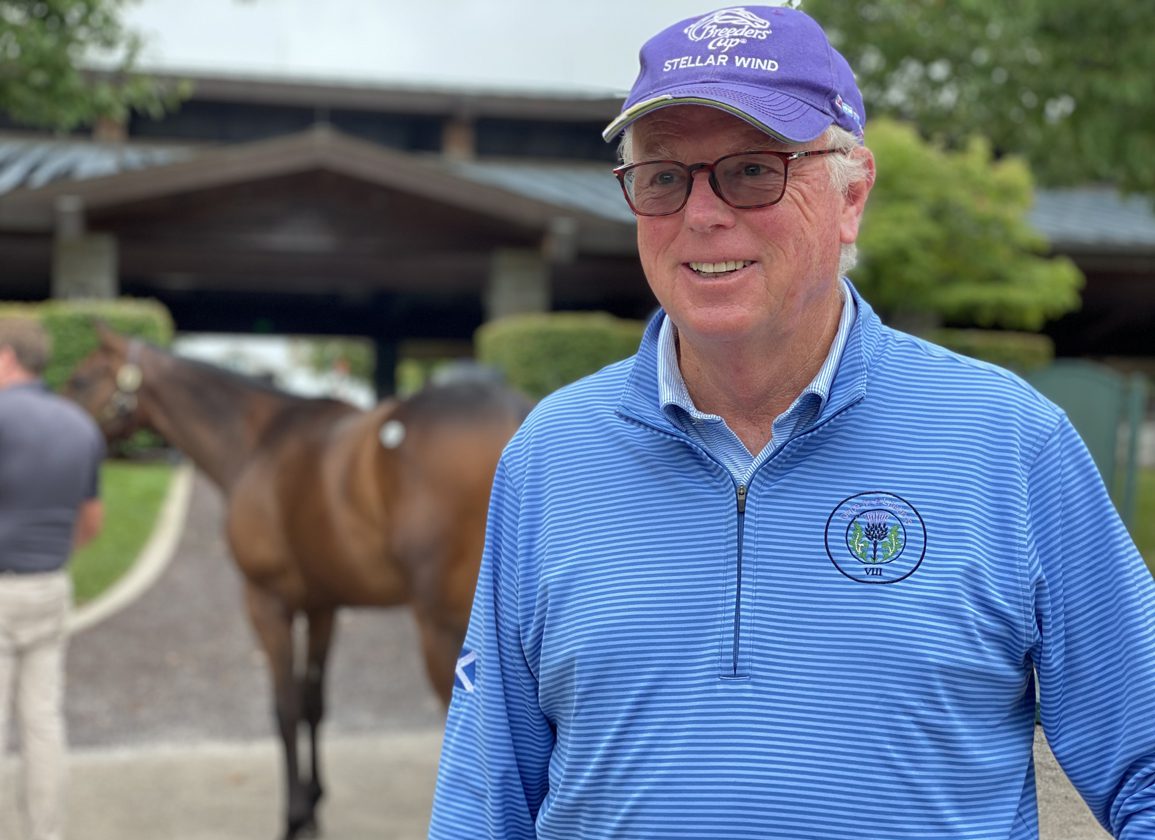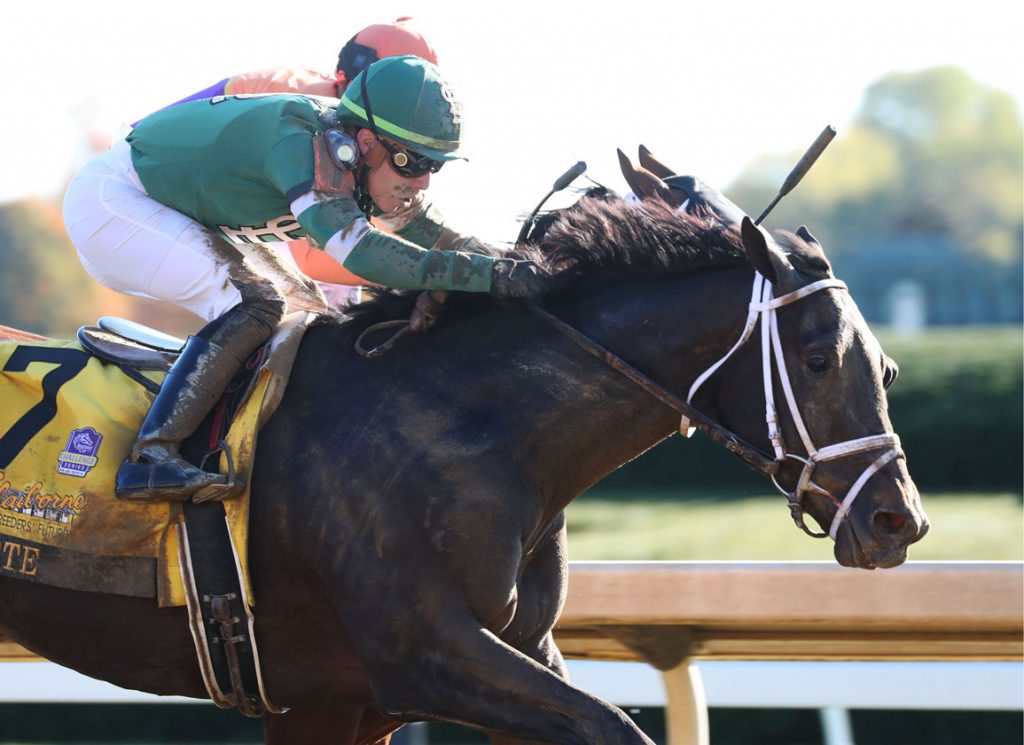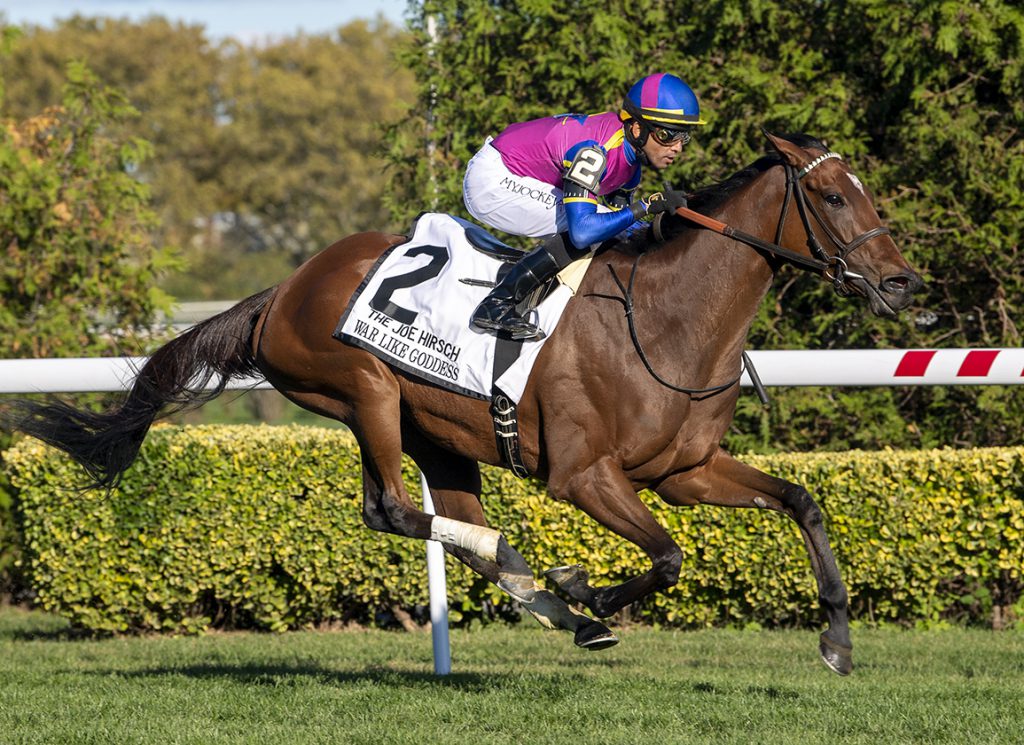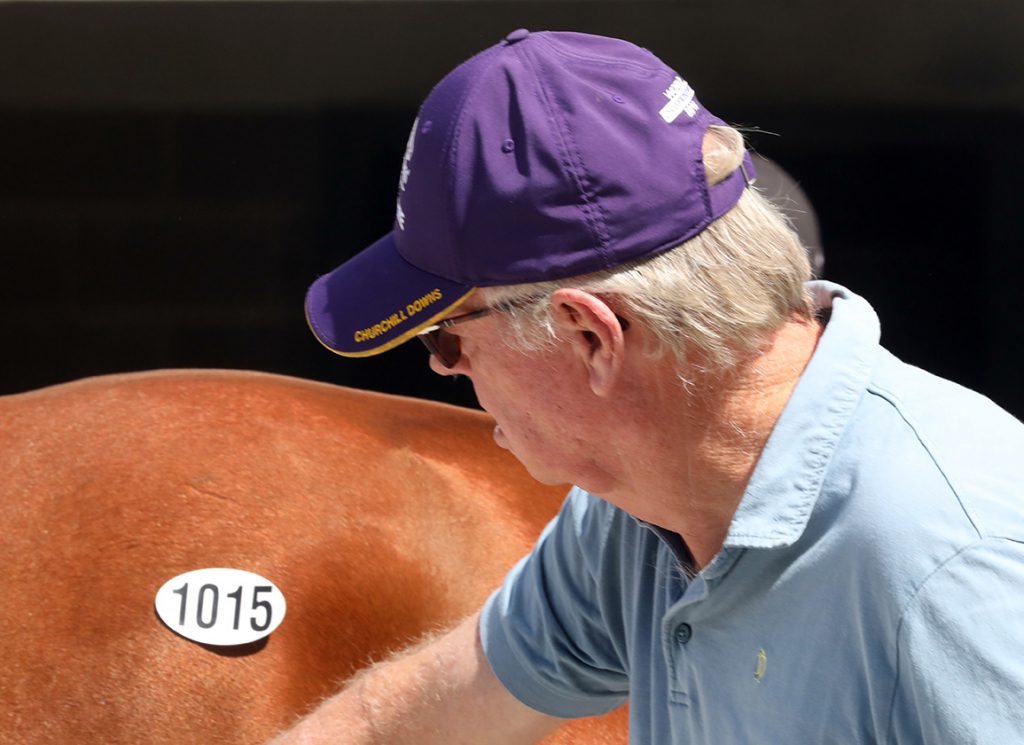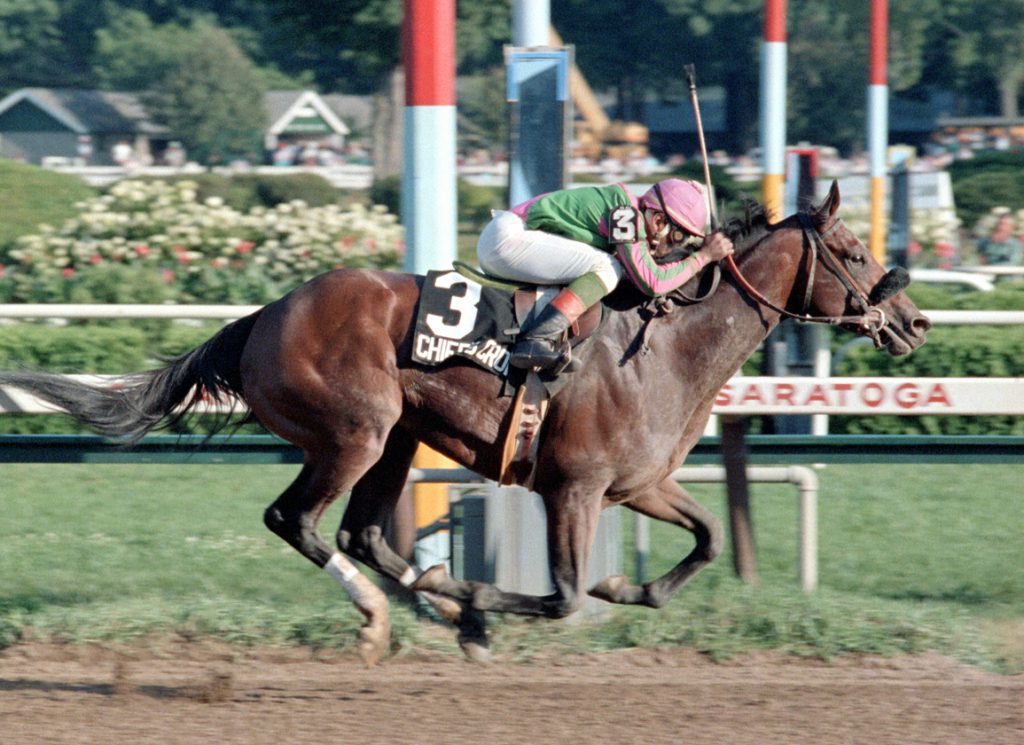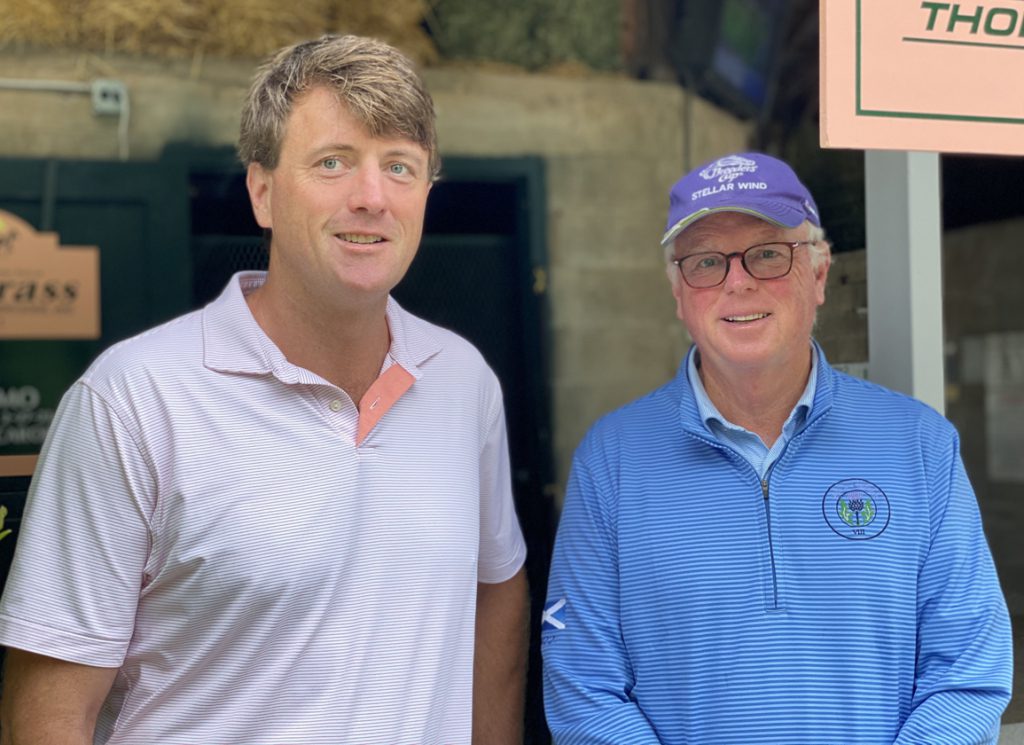By Chris McGrath
Two Grade I winners inside an hour last Saturday: both sold as November weanlings at Keeneland, both through the same consignment. But while their shared provenance at least guarantees that you'll want to drop by the Bluegrass Thoroughbred Services draft this time round, as well, it is not as though Forte (Violence) and War Like Goddess (English Channel) can otherwise elucidate the vagaries of our business.
Because while one made respectable money, the other was more or less given away. War Like Goddess, swept up in the kind of cull essential to a program on the scale of Calumet, mustered a solitary bid beyond her reserve and was lost for $1,200.
“But the guy I sold her to, he couldn't get the grand with Taylor Made next fall!” notes John Stuart. “Which means I'm a better salesman than all those guys!”
His chuckle makes plain the levity of this claim. But there is a more serious point, which he can expand by recalling another filly sold for the same client. In 2013, Stuart topped the Saratoga sale for Brad Kelley with a daughter of Dynaformer at $1,225,000–and, to be fair, she did actually go on to make the podium in a couple of graded stakes for Three Chimneys. In the adjacent stall, however, a Virginia-bred Curlin filly had been almost entirely ignored while her neighbor was shown and vetted.
“Came from Peggy Augustus' Keswick Stud,” Stuart recalls. “And she ended up the lowest-price horse in the sale. Anybody could have played for her at $40,000. If you had enough money to buy lunch at Saratoga, which is expensive, you could probably have gotten in the group of four bidspotters that bought her. They pinhooked her back to Timonium that October and she brought $86,000.”
Not bad, for a flip of barely two months. But the next time this filly came under the hammer she made $6 million as six-time Grade I winner Stellar Wind.
So you never know. War Like Goddess (whose much lamented sire, incidentally, was acquired for Kelley by Stuart) was eventually found by Donato Lanni at the 2-year-old sales, for $30,000, and has so far banked over $1.6 million. Forte, for his part, realized $80,000 as a weanling pinhook, making moderate gains when sold to Repole Stable and St. Elias Stables for $110,000 the following September. But he has now added the GI Breeders' Futurity S. to the GI Hopeful S., and Amy Moore of South Gate Farm is prudently taking her chance to consolidate what remains a young operation. His half-brother by Uncle Mo made $850,000 to Mayberry Farm at the September Sale, while their young dam Queen Caroline (Blame), in foal to Not This Time, sells as Hip 222 at Fasig-Tipton next month.
Though not strictly Virginia-bred like Stellar Wind, Forte is as close as you can get. “He was bred by a Virginia breeder–first horse she ever bred–and raised on a Virginia farm,” Stuart says. “And, incidentally, he was the lowest-price horse that the Repole crowd bought last year. Of all those expensive horses, he's the one that has hit.”
If there is a note of pride in his voice, that's fair enough. For Stuart himself was not only raised in Virginia, but on no less iconic a farm than Llangollen. His mother, Tessa (subsequently Dole), who had arrived from England after the war as an aspiring show rider, was taking schoolgirls from nearby Foxcroft out hunting when she met–and was hired by–the farm's celebrated owner.
“Liz Whitney Tippett had gotten the largest settlement in American history when she divorced Jock Whitney because he wouldn't make her Scarlett O'Hara in 'Gone with the Wind',” Stuart says. “And of course she had this 1,000-acre farm in Upperville that was her wedding present from him. So she had everything. And my mother, for 10 years, was the person who knew where all the horses were, what their names were, what they were doing.
“So we lived on the farm, mother did the horse stuff and my father had the evening duty. He would go to the Dulles airport and pick up some young trainer by the name of Whittingham and a rider, Arcaro, that mother had to mount in the fox hunt the next day! Whittingham was too smart for that. But they all came through there, the Aga Khan, everybody.”
Liz was actually Stuart's godmother, but she had evidently lost some of her sunshine by this stage of her life and his family, expanded to three sons, eventually moved on. They remained local in Clarke County, however, his father having been grandson of a Winchester doctor who had practised to 93. (On finally retiring, he received a citation from President Eisenhower in person.)
“We had a feed store in Berryville and sold a bunch of feed and hay to the horses at Charles Town,” Stuart recalls. “And we were lucky to get paid. My father wasn't interested in the horses, he just sold the feed, so it was my mother had to hustle the horses all her life.”
Stuart wryly relates a pivotal chapter in family folklore that might have given them all an easier life. His maternal grandfather, a Manchester cotton man, had manufactured typewriter ribbon; but when he died, IBM having decided that they didn't need ribbon anymore, the far-sighted trustees decided to divert his stake to a sounder investment than this passing fad for computer screens.
“Unfortunately they instead decided to make disposable cotton underwear for Englishwomen,” Stuart says, shaking his head. “And that busted the company. But it made my mother work harder in life. She went into the bloodstock business in America, and I got to learn. So something good came out of it…”
Sure enough, his mother took a 20% stake when another Clarke County horseman, Tyson Gilpin, in 1958 founded what Stuart acclaims as the first bloodstock agency in America.
“Say Bull Hancock wouldn't give you a season,” he explains. “And he was tough to get a season off, for a good horse. Then a shareholder could sell it privately and the Stallion Service Bureau was the first to do that for you.”
Even today few would consider the situation adequately improved, but those were certainly tough times for a woman in the horse business. But Tessa made a success of her pioneering role in a pioneering venture for a dozen years or so.
“My mother was independent, really a go-getter in a quiet, English way,” Stuart reflects. “There was no money at the time, and we all had to work as kids. I had to work my way through college. I was 14 when I had my first job at Saratoga, showing for Tyson. That would have been 1964.
“And then I worked for all the Virginia places, because in that era there were still a dozen really good breeders out there. People from all over the world would come in June and start in Charlottesville at the Van Clief farm, work their way up to Middleburg, and look at all the yearlings. So I was lucky, because it's nearly all gone now.”
In the heyday of the Virginian Turf, the Gilpin family had been able to import horses like Teddy (Fr) to Kentmere, but now came serial migrations to Kentucky: the Hancocks left, the stallions left, and the mares followed them.
“State of Virginia didn't do much to help,” says Stuart with a shrug. “They have now, with the Virginia Certified Program, that was a great idea. But the breeding, it's gone everywhere except for Kentucky. I mean, there's breeding everywhere. But if you're not in Kentucky, you're not commercial.”
And, actually, Stuart himself contributed to that revolution.
“When I first came here and put my sign out with my partner Peter Bance from Richmond, Virginia in 1980, the business was evolving,” he explains. “Because, you know, those old hardboots didn't prepare their horses well; didn't show them right. And so a group of us came in. Billy Graves, Fred Seitz. I'd been taught how to groom and show, I'd won a National Pony Club championship. And we also had a little different ethical standard. Some of those hardboots, they were interested in the one-night stand–not a honeymoon!”
Stuart had started in the Bluegrass with a couple of years selling and advertising seasons for Spendthrift, just about the time Seattle Slew arrived. With the commercial market just taking off, it was a promising time to be seeking out new angles and opportunities. For instance, here came the young guy who had bought Meadow Stud back in Virginia, asking Stuart to fill the paddocks that had introduced Secretariat to the world. It so happened that there was a Contagious Equine Metritis scare just then, so Stuart did a deal with a shipping company to take stock for their month of isolation. And this also happened to be the summer that Sheikh Mohammed was sending the market into the stratosphere.
“He came to the summer sale at Keeneland and bought the highest-price filly in history, and the highest-price colt,” Stuart recalls. “And next thing I knew I was meeting six Sallee vans full of horses, Wednesday morning at the Meadow Stud. And then, in September, he bought about 100 more. Well, out of that whole bunch they got one little sprinter, Ajdal.”
But later dealings would prove very fertile, both for the Sheikh's team and Stuart. For example, he sold them G1 1,000 Guineas winner Blue Bunting (another Dynaformer filly bred by Brad Kelley) for $200,000 at Saratoga. And when he sent an Argentinian mare for what proved the final foal-share to Dubai Millennium, the Sheikh asked to buy her after losing his cherished young stallion. Urged to return to the same talent pool, Stuart found another Argentinian mare to send to Rahy and the result was Godolphin stalwart Rio de La Plata.
The South American scouting avenue had first opened through Roy, the son of Fappiano he brought back to syndicate in Kentucky.
“I flew down, didn't have any money, and the horse walked out of the stall,” Stuart recalls. “And he had a look of eagles about him. They wanted $1 million and I said, 'I'll take him.' And though he didn't really work in America, every country I leased him to–Brazil, Argentina, Chile–he was leading sire.”
Then he helped to import Blue Prize (Arg) (Pure Prize) to win the GI Spinster S. twice and the GI Breeders' Cup Distaff for Merriebelle.
“They don't hothouse them like we do,” he says of the South American breed. “And remember that in Argentina they race more like the United States than any country in the world. They run on the dirt, they go around our way, they get after their 2-year-olds. They make horses tough. And so if you're buying the best of the crop, they'll have gone through a lot to get the special one.”
But the turning point was perhaps when Carl Rosen's son Andrew revealed a precocious wisdom in sorting out his father's estate.
“I got really lucky,” Stuart admits. “I was running low on funds, a young, struggling bloodstock agent with two sons. And they had this Danzig colt out of Six Crowns, who was a Secretariat daughter of Chris Evert. And Andrew said, 'If the estate needs some money, I can move this 2-year-old.' This was in June, he was still unraced. By the end of the summer, he was the best 2-year-old in the country: Chief's Crown. And I sold a half-interest in him to Robert Clay for $10 million cash. A half-interest!
“So I had my commission and got myself out of jail, and the horse won the first Breeders' Cup race. And I get to know this 25-year-old, Andrew Rosen. Hell, we've talked about every day ever since.”
Stuart was asked to handle the dispersal of the rest of the Chris Evert family.
“There was one that seemed much the most unlikely to be of merit,” he recalls. “She'd never run, she was huge, she had a tube hanging out of chest. Nijinsky Star. I guess there's been 30 graded stakes winners come through her for Juddmonte.”
Few horsemen can compete with the influence of Stuart's draft at that auction, which also included another mighty matriarch, Toll Booth, sold for John M. Schiff. But perhaps there is one legacy, a very literal one, that means even more to this proud Virginian.
“One of my favorite things in my professional career is that I got to sell the last crop of yearlings for Paul Mellon,” Stuart says. “As a result, I got to know the trustees. And, in his will, he had said: 'If you ever run across a really good charity that takes care of retired horses, then you can support it.' Well, at the time, I was president of the Thoroughbred Retirement Foundation. And, in three different pops, I was able to get them $8 million from the Mellon estate. They gave $4 million to the Brits, too, because he was of course a great anglophile. But what was most important was not so much the money as the old guard saying to themselves, 'If Paul Mellon says we need to do this, then we need to do it.'”
Much of the change Stuart has observed in the business has nourished his own progress. Equally, however, he feels that some old principles are nowadays unduly overlooked.
“Okay, it's a lot more sophisticated now,” he concedes. “In the old days, you'd walk around with your trainer and buy your horses. Now you've got 30, 40 agents backed up with cardio, X-rays, DNA samples, and every other thing. The one thing they don't do much is study the pedigree. Back then, pedigree was the big thing.
“I do remember, as a young consignor, when James Delahooke came along with Guy Harwood, they'd make you walk and walk and walk. And of course he was very good at it. But now it's gone too far the other way. It's all about the physical–and they all follow the same horse.”
Needless to say, no less than his patrons with War Like Goddess, Stuart knows perfectly well what regret feels like. He sold Army Wife (Declaration of War) for $50,000 as a short yearling, and she has now earned close to seven figures. So none of us ever stops learning. Sure, now that he has tipped 70, Stuart is spending a little more time in Florida in winter and Maine in summer and is relying on his son, Sandy, to run the agency day to day. But it was only in recent years that he started, after due research, assembling a dozen mares of his own.
“And they've been spectacular,” he says. “I probably didn't give more than $50,000 for any of them, but I already have six silver cups for graded stakes. And no, I'm not going to tell you how I pick them!”
Stuart credits his wife, Douglas Wise Stuart, for her contributions to the team, as she painstakingly combs through the race records of every mare offered at the breeding stock sales.
One admitted ingredient, however, is that the mare could run. That, after all, is something he could have learned from his own pedigree.
“My mother died a couple years ago,” Stuart says. “She spent her last 20 years here in Lexington, said the country reminded her more of England than anywhere she'd been in America. Founded the Woodford Hounds here. Nothing fancy about her. Loved her dogs, loved her horses. But she was genuinely loved by those that knew her.”
Maybe she could have bought Llangollen itself, if only those trustees had stuck with IBM. But while Stuart would have been richer that way, the same could hardly be said of the life he has led.
Not a subscriber? Click here to sign up for the daily PDF or alerts.





